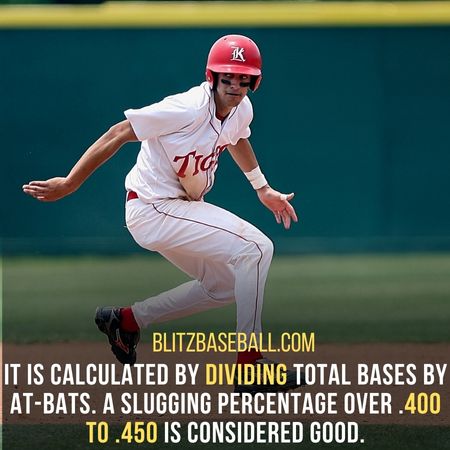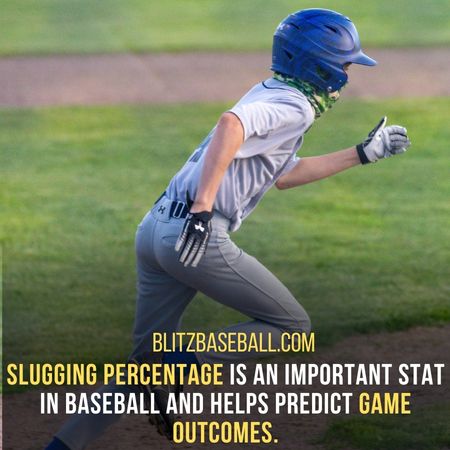What is slugging percentage in baseball is an important question in baseball. Slugging percentage is a crucial statistical measure in baseball that quantifies a player’s power productivity. By dividing the total bases earned by the number of at-bats, the slugging percentage provides insight into a player’s ability to generate hits resulting in more than a single base.
This article aims to delve into the concept of slugging percentage, covering its calculation and interpretation, its significance in baseball, and its application in strategy development.
Understanding slugging percentage contributes to predicting game outcomes, evaluating player performance, and optimizing coaching strategies.
Key Takeaways
- Slugging Percentage measures power productivity, not walks.
- It is calculated by dividing total bases by at-bats.
- A Slugging Percentage over .400 to .450 is considered good.
- Slugging Percentage is an important stat in baseball and helps predict game outcomes.
What Is Slugging Percentage in Baseball?
Slugging Percentage is a statistic used in baseball to measure power productivity. It provides insights into a player’s ability to hit for extra bases and their overall power. The formula for calculating Slugging Percentage includes the total number of bases a player has earned, which is determined by adding up singles, double plays, triples, and home runs.
This statistic is an important tool for evaluating a player’s performance and predicting game outcomes. A Slugging Percentage over .400 to .450 is considered good, while an outstanding Slugging Percentage falls between .500 to .550. Elite hitters often have a career Slugging Percentage over .650.
Coaches and strategists use Slugging Percentage to make informed decisions and plan strategies based on a player’s power productivity.

Calculation and Interpretation
Calculation and interpretation of the slugging percentage involves dividing the total bases by the number of at-bats, providing a measure of power productivity in baseball.
The total bases are calculated by adding the number of singles to twice the number of doubles, three times the number of triples, and four times the number of home runs. This formula gives weight to extra-base hits, reflecting a player’s ability to hit for power.
Interpreting the slugging percentage can help evaluate a player’s performance. A slugging percentage over .400 to .450 is considered good, while an outstanding slugging percentage falls in the range of .500 to .550.
Elite hitters have a career slugging percentage over .650, indicating a high level of power and productivity. A slugging percentage over .550 is also considered impressive, while a perfect slugging percentage is 4.000, achieved by hitting a home run on every swing.
Importance in Baseball
The significance of slugging percentage in baseball extends beyond individual player performance and serves as a fundamental statistic for decision-making and game strategy.
Slugging percentage provides insights into players’ power productivity by measuring their ability to hit for extra bases.
It helps coaches make better strategies by understanding opponents’ slugging percentages and planning accordingly.
Moreover, slugging percentage serves as the base formula for other important stats that further aid in evaluating player performance, such as OPS (On-Base Plus Slugging) and wOBA (Weighted On-Base Average).
By considering slugging percentage, teams can predict game outcomes and assess players’ abilities and forms.

Therefore, slugging percentage plays a critical role in baseball, providing valuable information for strategic planning and player evaluation.
Using it for Strategy
Coaches can utilize slugging percentage as a strategic tool in making informed decisions and devising effective game plans. By understanding the slugging percentage of their opponents, coaches can identify their strengths and weaknesses and adjust their defensive strategies accordingly.
For example, if an opposing player has a high slugging percentage, indicating strong power hitting ability, the coach may choose to position their outfielders deeper or employ defensive shifts to counteract their hitting prowess.
On the other hand, if a player has a lower slugging percentage, the coach may opt for a more aggressive pitching approach or focus on defensive positioning to limit their offensive impact.
By incorporating slugging percentage into their strategic analysis, coaches can make well-informed decisions that increase their team’s chances of success on the field.
Frequently Asked Questions
How does a player’s slugging percentage impact their overall performance in baseball?
A player’s slugging percentage in baseball is a measure of their power productivity. It indicates the player’s ability to hit for extra bases, such as doubles, triples, and home runs. A higher slugging percentage generally indicates a stronger overall performance.
Can a player have a high slugging percentage without hitting many home runs?
Yes, a player can have a high slugging percentage without hitting many home runs. Slugging percentage takes into account all extra-base hits, including doubles and triples, which contribute to a player’s power production.
Are there any disadvantages or limitations to using slugging percentage as a stat?
There are some disadvantages and limitations to using slugging percentage as a stat. It does not take into account other factors such as walks and situational hitting. It also does not consider the quality of the opposing pitchers faced.
How does a player’s position in the batting order affect their slugging percentage?
A player’s position in the batting order can affect their slugging percentage. Generally, players higher in the order have more opportunities to hit with runners on base, which can lead to more extra-base hits and higher slugging percentages.
Can a player’s slugging percentage vary significantly from season to season, and if so, what factors contribute to this variability?
Yes, a player’s slugging percentage can vary significantly from season to season. Factors that contribute to this variability include changes in the player’s skill level, injuries, changes in the team’s lineup and strategy, and variations in the quality of opposing pitchers and defenses.

Conclusion
In conclusion, slugging percentage is a significant statistic in baseball that quantifies a player’s power productivity. It is calculated by dividing the total bases earned by the number of at-bats and only considers hits resulting in more than a single base.
A slugging percentage over .400 to .450 is considered good, while anything over .500 to .550 is outstanding. Coaches use this statistic to make better strategies, and understanding opponents’ slugging percentage aids in planning.
Overall, slugging percentage provides valuable insights into players’ abilities and helps predict game outcomes.
